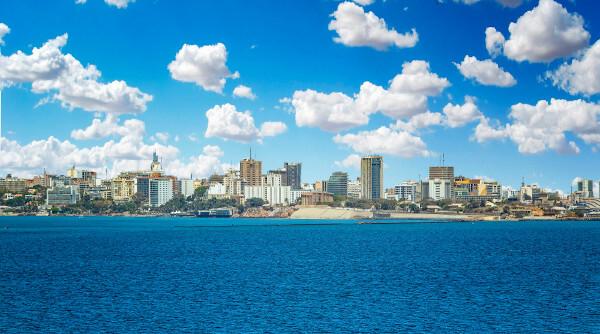A flag of Senegal It is one of the country's national symbols. Its current version was adopted on August 20, 1960, and is formed by three vertical stripes in green, yellow and red, with a centralized green star. These colors have different meanings, such as their derivation from the Pan-Africanist movement and the individual symbology, they represent also the Islamic religion, hope (green), wealth, the arts (yellow), life and strength in the fight against underdevelopment (red). The star, in turn, symbolizes the heavens, spirituality and union.
Read too: Flag of Saudi Arabia — another flag that features elements of the Islamic religion
Summary about the flag of Senegal
The flag of Senegal is a national symbol of the country.
Rectangular in shape, it is composed of three vertical stripes of the same width in green, yellow and red. In the center of the flag is a five-pointed green star.
The colors are representative of Pan-Africanism but also have other meanings.
Green represents the Islamic religion, prosperity and hope; yellow, wealth, arts and spirit; the red, the lives of those who fought for Senegal and the commitment and strength in the fight against underdevelopment.
The green star represents Senegal's unity, spirituality and openness to continents.
The current Senegalese flag was adopted on August 20, 1960, when the country became independent.
Senegal flag meaning
the flag of senegal éone of the national symbols of the country. Rectangular in shape, it is made up of three vertical stripes of the same size in green, yellow and red, in that respective order starting from the mast. In the center of the yellow band is a green three-pointed star. Generally speaking, the Senegalese flag represents prosperity and progress and brings elements that represent the Islamic faith, predominant in the country.

→ Meaning of the colors of the flag of Senegal
The flag of Senegal is made up of three colors, each of which has a particular meaning. As a set, the colors of the Senegalese flag still represent the pan-africanism, a sociopolitical and philosophical movement that emerged in the 19th century and proposes the union and defense of the rights of the population of continent Africa.
Below, we present the individual meaning of the colors of the Senegalese flag.
Green: it is present in the left vertical band, always located close to the mast, and also in the star positioned in the center of the flag. This is one of the colors that represents the islamic religion and the Pprophet Mohammed, being widely used in the flags of Muslim countries, in addition to symbolizing prosperity and hope. The Senegalese government also highlights the meaning of green in other religions and beliefs, such as in Catholicism (hope) and animism (fertility).
Yellow: makes up the central band of the Senegalese flag. It symbolizes natural wealth and the fruit of work, literature, the arts and the spirit.
Red: makes up the track on the right, farthest from the mast. This color represents the life and blood of those who fought and still fight for Senegal. In addition, red symbolizes the commitment and strength of all those who fight the country's underdevelopment.
→ Senegal flag symbol meaning
The symbol on the flag of Senegal is a five-pointed green star which appears centered over the yellow band. According to the Senegalese government, the star represents the opening of Senegal to the five inhabited continents, as well as being a symbol for heaven and spirituality. The star is present on the flag of other African countries, thus also being a symbol for unity.
Senegal flag history
The first known national flag of Senegal dates from 1958, when it was still part of the French colonial territories on the African continent. During most of French rule, however, the Senegalese were prohibited from having a flag of their own under the "risk", in the view of the colonizers, this symbol unleashed a nationalist feeling and, therefore, started an uprising in favor of independence.
Since the 1950s, the Senegalese flag has a green background on which a five-pointed yellow star appears centrally. At the end of the decade, more precisely in April 1959, the Senegalese territory joined the Mali, forming the Federation of Mali, which had its own flag.
The colors were the same as the current flag of Senegal, with the difference that, in the center, instead of a green star, there was a black symbol representing a human figure, known as kanaga.
As of August 20, 1960, however, Senegal became a sovereign nation and adopted the flag we know today.
See too: Flag of Costa Rica — the flag of a small nation located in America
Main characteristics of Senegal
Senegal, also called the Republic of Senegal, is a african country located in the West African region. The city of Dakar, located on the coast, is its capital.
The Senegalese territory, due to the maritime nature and the influence of winds hot and dry northeast, presents climates that vary from tropical to the semiarid. Its vegetation is formed, for this reason, by steppes It is savannas, with few areas of forest It is mangrove. O relief Senegalese is characterized by plains and gently undulating terrain.

A population from Senegal is today from 17,196,000 inhabitants, and has grown rapidly due to the high birth rates registered in the country. Most Senegalese live in the countryside, although there are large cities like Dakar, whose population reaches 3 million inhabitants.
Senegal has a low development index and an economy considered underdeveloped.The. The country is a major producer of peanuts and fish products, in addition to having its economy based on the exploitation of mineral resources and the tourism, growing activity in the country.
Facts about the flag of Senegal
The colors of the Senegalese flag also represent the three parties that came together to form the Senegalese Progressive Union in 1958.
It is said that the tricolor scheme was also inspired by the flag from France.
Like the Senegalese flag, several other national flags use Pan-African colors. The flag of Mali, for example, can be confused with that of Senegal, the only difference between them being the absence of the green star.
By Paloma Guitarrara
Geography Teacher
Source: Brazil School - https://brasilescola.uol.com.br/geografia/bandeira-do-senegal.htm


